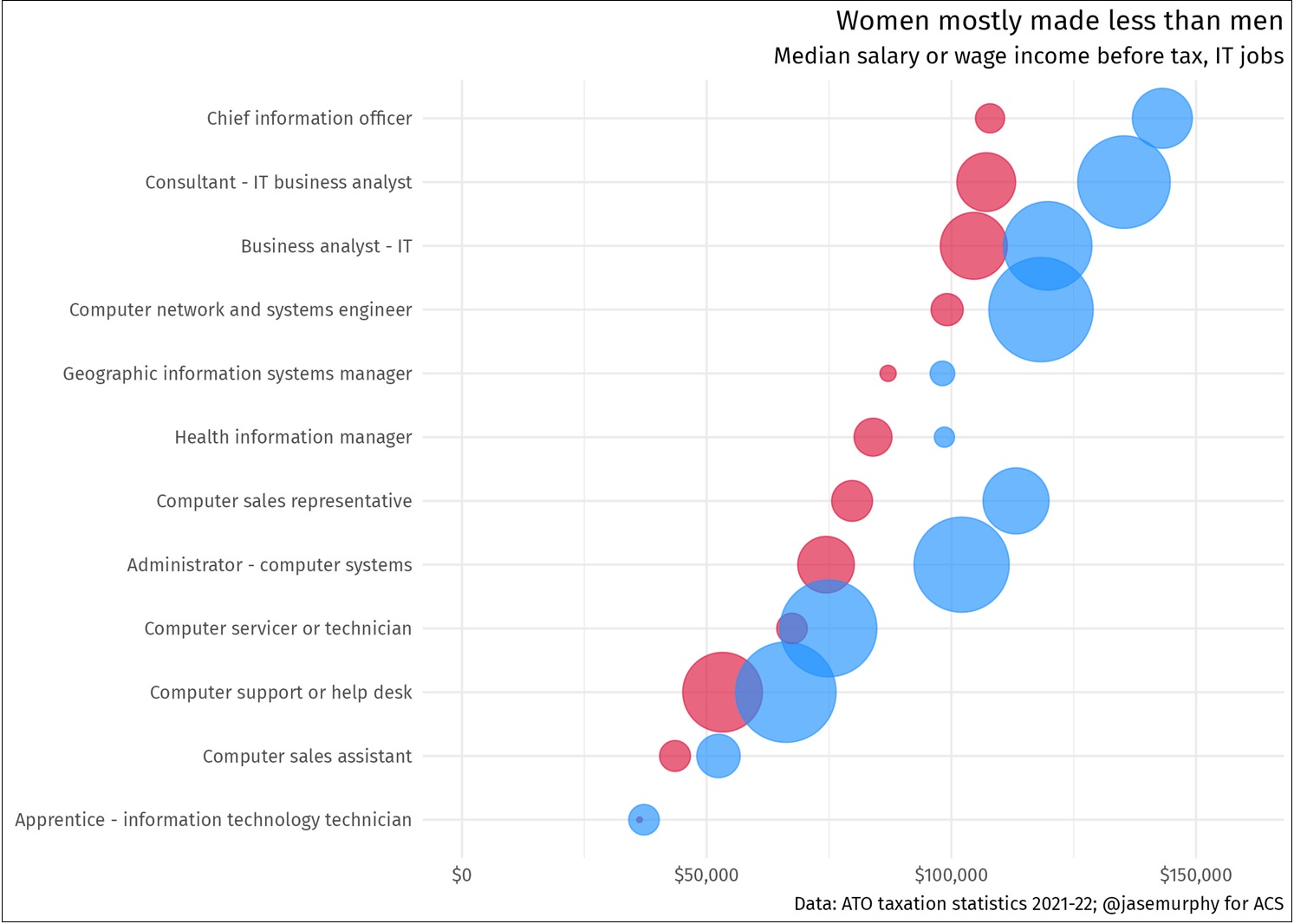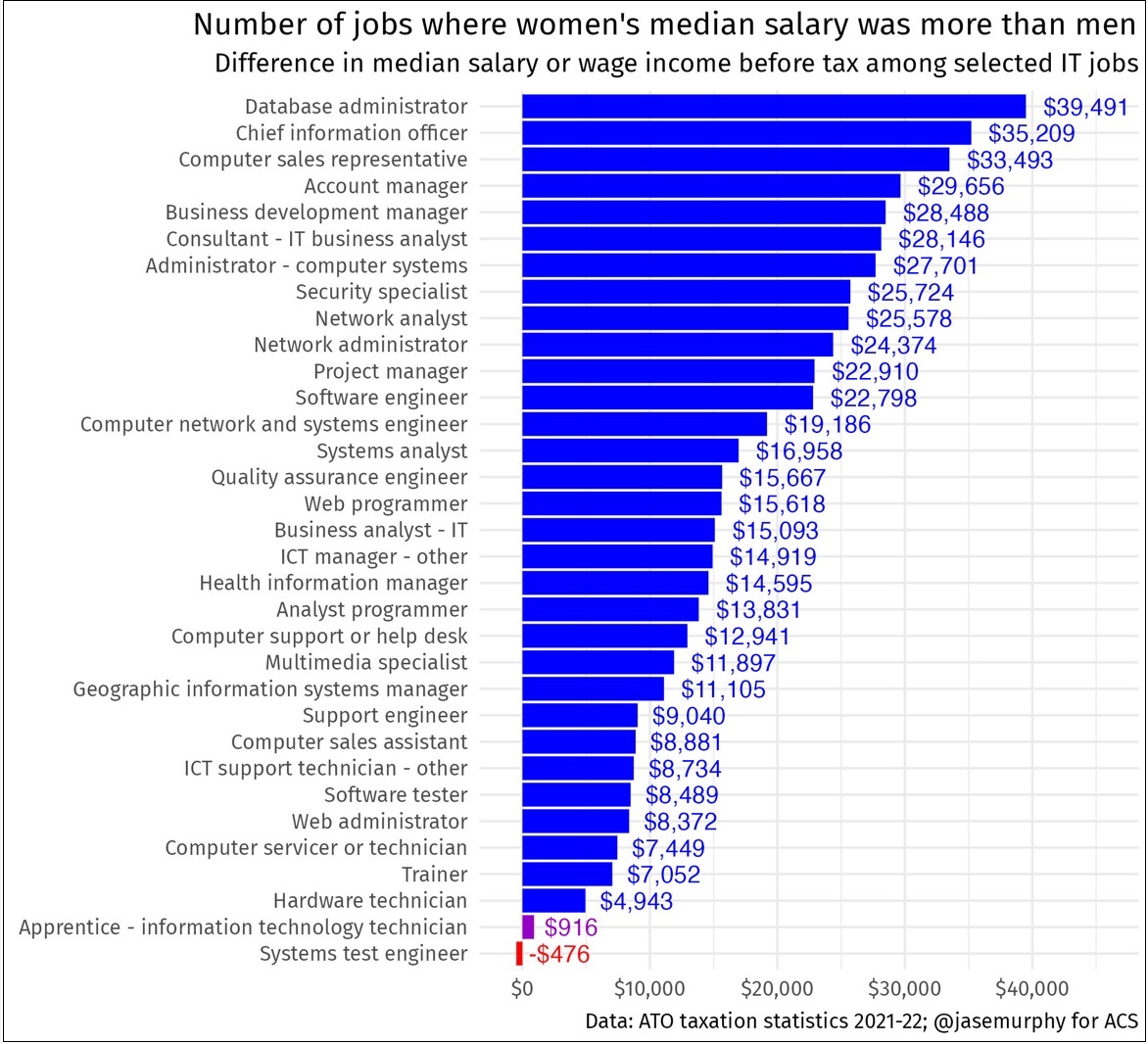The Australian economy is rife with jobs where women earn less than men.
But how does IT compare?
It’s a great question, and with the recent release of some astonishingly detailed information from the ATO, we can answer it.
The ATO data is special because it breaks down earnings to an extremely granular level, letting us peep at the average and median earnings for jobs as specialised as IT business analyst or geographic information systems manager.
The chart below gives a glimpse of what I’m talking about.
It shows median salary for a range of IT jobs, from apprentice to CIO.
The size of the circle indicates how many people do each job and the horizontal axis shows the pay.
Median male CIOs made over $140,000 per year for example – some $35,000 more than their female counterparts.
The difference between male and female pay is lowest for apprentice IT technicians, on the bottom row.

The median is a way of getting a typical value.
Imagine getting all the workers and lining them up from lowest paid to highest paid and checking the salary of the middle person: that’s the median.
Averages are different, they can be dragged up by outliers.
If me and Jeff Bezos are in a room, we are both billionaires on average. But I’m asking him to buy the drinks!
If we explore the same data by averages, we see a different pattern.
Average pay is higher, pay gaps are slightly expanded in most cases, and among the apprentices, women now earn more than men on average.

Now, the chart above shows just a selection of the jobs in the ATO’s dataset. There’s more. Here’s the full list, graphed in a different way, showing the difference between male and female pay.
The biggest gap is not actually for CIOs, it is in database administration, where the median man made almost $40,000 more per year than the median woman.

As the chart shows, there is one solitary IT occupation where median women made more than men – systems test engineers.
In that category, the median woman outearned the median man by $476.
(If we re-run this data with averages, the gaps get bigger and the number of jobs where the average woman out-earns the average man falls to zero.)
But of course, IT is a relatively well-paid industry.
How big are these earning gaps in percentage terms?
Are they out of line with the rest of the economy?
As the next chart shows, in some jobs the pay gaps are big.

We can compare median pay gaps in IT to the rest of the economy.
IT jobs are certainly not at the very top, which is an echelon stuffed with specialist doctors.
The median pay gap for database administrators is higher than the gap for surgeons though, sitting just a little below the pay gap for footballers.
The next chart has the top 25 professions for median pay gaps.
Two IT jobs are shown, ranked 20th and 24th.

Most IT jobs have a pay gap above the median pay gap, which is $12,000.
The industry certainly has work to do.
But of course, the gap between male and female pay is not, by itself, evidence of discrimination by firms.
The gap is usually more of a social outcome, explained by multiple factors:
- women often work part-time
- women may have time off during their career that impedes progress to the highest levels of the organisation
- women may choose roles that deliver better work-life balance.
But this can create a culture where the norm is for women not to be senior or highly paid, and that can be self-reinforcing.
Which is to say, discrimination can emerge insidiously!
It’s worth noting that pay gaps are larger in male-dominated industries.
This data is unparalleled for its granularity.
The trade-off is of course freshness – it is from 2021-22. So, it covers period from 3.5 years ago to 2.5 years ago.
Luckily, we can check in with some more recent data to see progress since.
The 2023-24 Workplace Gender Equality Agency (WGEA) report shows that median pay gaps have dropped in the last year.
And the drop has been largest in male-dominated industries.
The Information Media and Telecommunications sector has seen the median gap in total remuneration fall sharply to 10.6 per cent.
Which is good news for women, and for the industry.










